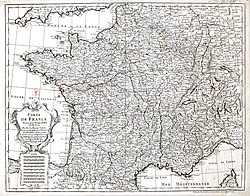Francia
Frankish kingdom from 481 to 843 / From Wikipedia, the free encyclopedia
Dear Wikiwand AI, let's keep it short by simply answering these key questions:
Can you list the top facts and stats about Francia?
Summarize this article for a 10 years old
The Kingdom of the Franks (Latin: Regnum Francorum), also known as the Frankish Kingdom, the Frankish Empire (Latin: Imperium Francorum) or Francia, was the largest post-Roman barbarian kingdom in Western Europe. It was ruled by the Frankish Merovingian and Carolingian dynasties during the Early Middle Ages. Francia was among the last surviving Germanic kingdoms from the Migration Period era.
Kingdom of the Franks | |||||||||||||||||||||||
|---|---|---|---|---|---|---|---|---|---|---|---|---|---|---|---|---|---|---|---|---|---|---|---|
| 481–843 | |||||||||||||||||||||||
 Expansion of the Frankish kingdom 481–870 | |||||||||||||||||||||||
| Capital | 47°14′24″N 6°1′12″E | ||||||||||||||||||||||
| Common languages | Frankish, Latin, Vulgar Latin, Old French | ||||||||||||||||||||||
| Religion | Originally Frankish paganism; most of the Frankish elite shifted to Catholic Christianity by 751 AD[1] (among Gallo-Roman (people); however Christianity had largely supplanted paganism at the beginning of the 9th century). | ||||||||||||||||||||||
| Demonym(s) | Frankish, Frank | ||||||||||||||||||||||
| Government | Monarchy | ||||||||||||||||||||||
| King of the Franks | |||||||||||||||||||||||
• 481–511 | Clovis I | ||||||||||||||||||||||
• 558-561 | Clothar I | ||||||||||||||||||||||
• 613–629 | Chlothar II | ||||||||||||||||||||||
• 629–639 | Dagobert I | ||||||||||||||||||||||
• 751–768 | Pepin the Short | ||||||||||||||||||||||
• 768–814 | Charlemagne | ||||||||||||||||||||||
• 814–840 | Louis the Pious | ||||||||||||||||||||||
| Historical era | Middle Ages | ||||||||||||||||||||||
• Established | 481 | ||||||||||||||||||||||
| 496 | |||||||||||||||||||||||
| 25 December 800 | |||||||||||||||||||||||
| 843 | |||||||||||||||||||||||
| Area | |||||||||||||||||||||||
| 814 est.[2] | 1,200,000 km2 (460,000 sq mi) | ||||||||||||||||||||||
| Currency | Denier | ||||||||||||||||||||||
| |||||||||||||||||||||||
Part of a series on the |
||||||||||||||||||||
|---|---|---|---|---|---|---|---|---|---|---|---|---|---|---|---|---|---|---|---|---|
| History of France | ||||||||||||||||||||
 | ||||||||||||||||||||
|
||||||||||||||||||||
|
||||||||||||||||||||
|
Ancien Régime
|
||||||||||||||||||||
|
||||||||||||||||||||
|
||||||||||||||||||||
| Topics | ||||||||||||||||||||
| Timeline | ||||||||||||||||||||
|
| ||||||||||||||||||||
The original core Frankish territories inside the former Western Roman Empire were close to the Rhine and Meuse rivers in the north, but Franks such as Chlodio and Childeric I expanded Frankish rule into what is now northern France. A single kingdom uniting all Franks was founded by Clovis I, the son of Childeric, who was crowned King of the Franks in 496. He founded the Merovingian dynasty, which was eventually replaced by the Carolingian dynasty. Under the nearly continuous campaigns of Pepin of Herstal, Charles Martel, Pepin the Short, Charlemagne, and Louis the Pious—father, son, grandson, great-grandson and great-great-grandson—the greatest expansion of the Frankish empire was secured by the early 9th century, and is by this point referred to as the Carolingian Empire.
During the Merovingian and Carolingian dynasties the Frankish realm was one large polity, generally subdivided into several smaller kingdoms ruled by different members of the ruling dynasties. These coordinated but also regularly came into conflict with each other. The old Frankish lands, for example, were initially contained within the kingdom of Austrasia, centred on the Rhine and Meuse, roughly corresponding to later Lower Lotharingia. The Gallo-Roman territory to its south and west was called Neustria. The exact borders and number of these subkingdoms varied over time, until a basic split between eastern and western domains became persistent. After various treaties and conflicts in the late-9th and early-10th centuries, West Francia continued as the medieval Kingdom of France, while East Francia and Lotharingia came under the control of the non-Frankish Ottonian dynasty, and became the core of the medieval Holy Roman Empire.